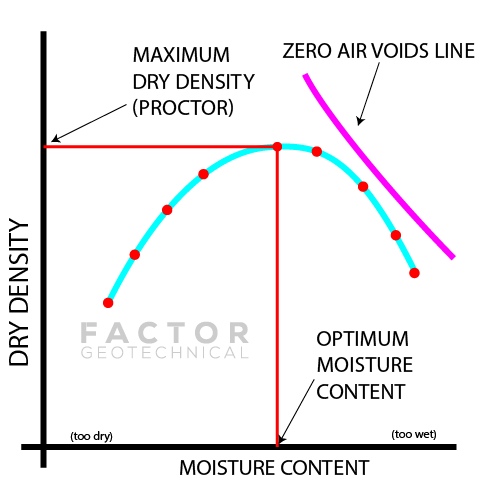Several important factors affect soil’s ability to be compacted, most importantly of which is the amount of water present in the soil. Also known as the moisture content of the soil, this measurement of the presence of water in soil is fundamentally important to the Proctor Compaction test and to earthworks and compaction in general.
What is Soil Compaction
Almost everyone knows “98% compaction” is a common specification in Calgary and across Alberta and that if you’re below 98% compaction, you have to keep compacting the fill. But what exactly are we engineers talking about when we specify a certain compaction percentage?
It’s pretty simple.
When you hear “98% compaction”, it just means that the geotechnical engineer has specified that fill must be compacted to 98% of the maximum dry density of the soil being used. So when you are below 98% compaction, the density of the soil being tested is still too low.
How is the maximum dry density determined? By performing the Proctor test on the same fill material being used on site in a geotechnical laboratory.
How Does Water Affect Soil Compaction?
If you’ve ever held a ball of really moist clay, you know how easily you can squish it in your hand and roll it into a ball. This is possible due to the water in the clay acting as a lubricant between the soil particles, allowing them to easily slide past each other and settle in closer together, increasing the density of the material. If there isn’t enough water? The clay is stiff and difficult to move around. The soil particles can’t slide past each other easily.
So we can just add a truck load of water and compaction won’t be a problem, right?

Not exactly. The obvious problem with adding too much water is that it becomes soft when it’s too wet – but why does it get soft?
While some water allows soil particles to slide past each other and interlock closely together, too much water does the opposite because water is incompressible. When there is too much water, the individual soil particles can slide around easily, but they can’t get close to each other because the excess water in the soil won’t allow it!
This is key for compaction testing. When we measure the compaction of a soil on site, we are measuring its dry density, not the density of the soil as it is during compaction. Because excess water does not allow the soil particles to get close together, when the soil has dried (after construction is complete), its density will be too low and we can run into issues such as settlement.
So, we need to find the balance between too much water and too little water.
How Does The Proctor Test Help?
The Proctor Compaction Test is a fairly simple test that is performed on multiple samples of the same soil. The only difference between each soil sample is their moisture content.
At Factor Geotechnical, we typically take a large enough sample of your soil so that we can make four different samples of the soil, each at different moisture contents.
We then apply the exact same amount of force to each sample, dry them all out, and weigh them. After this, we plot the results and determine the maximum dry density and optimum moisture content.
Check out this example Proctor graph below.

Starting from the left-most red dot on the blue line – looking directly down from this point we can see that this sample was very dry. Now look directly to the left of the left most dot – the dry density of this sample was very low. There was too much interparticle friction for it to be effectively compacted.
Now, follow the blue line up and to the right to the next red dot. This sample has more water in it, and was able to be compacted a little bit more. Follow this trend until the peak of the blue line.
This dot gives us the Maximum Dry Density or Proctor Density by looking to the left of the dot, and the Optimum Moisture content by looking below the dot. For this particular soil, the moisture content we provide will allow the soil to be compacted to its highest density.
These are the basis for the numbers we use on site. So when you hear 98% compaction, what it really means is 98% of the Proctor Maximum Dry Density, and this is why it’s so important to keep the moisture content of your backfill near the optimum value. Too wet or too dry, and you’re fighting the soil. Just right and you’ll be done soon.
Conclusion
The Proctor test gives you a number that you need, but it also tells you how your soil behaves. Take a look at the graph you get so you know how your soil reacts to changes in moisture content. Understanding it can save you time and money.
If you need compaction testing, proctor testing or any other geotechnical engineering assistance in Calgary, Edmonton, or anywhere in Alberta please fill out our contact form or give us a call.

